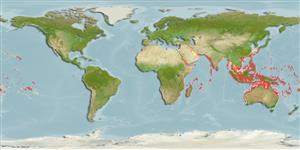分類 / Names
俗名 | 同種異名 | Catalog of Fishes(屬, 種) | ITIS | CoL | WoRMS | Cloffa
Teleostei >
Ovalentaria/misc (Various families in series Ovalentaria)
鱸形目 (Various families in series Ovalentaria) >
Pomacentridae (Damselfishes)
雀鯛科 (Damselfishes) > Chrominae
Etymology: Dascyllus: Greek, daskillys, -on = a kind of fish (Ref. 45335).
More on author: Rüppell.
Environment: milieu / climate zone / depth range / distribution range
生態學
海洋 礁區魚類; 非遷移的; 深度上下限 0 - 55 m (Ref. 7247). 熱帶; 32°N - 36°S, 24°E - 128°W
Indo-Pacific: Red Sea and East Africa to the Line and Pitcairn islands, north to southern Japan, south to Sydney, Australia. Not found in the Hawaiian and Marquesan islands.
印度-太平洋: 紅海而且東非到列島群島與皮特凱恩群島, 北至日本南部, 南至澳洲雪梨。 不出現在夏威夷與馬貴斯群島。
大小 / 重量 / 年齡
Maturity: Lm ? range ? - ? cm
Max length : 14.0 cm TL 雄魚/尚未辨別雌雄; (Ref. 89972); 最大體重: 45.21 g (Ref. 126022)
背棘 (總數) : 12; 背的軟條 (總數) : 14 - 16; 臀棘: 2; 臀鰭軟條: 14 - 15. Juveniles overall black with scale centers bluish; white blotch on forehead and upper sides; all fins black except the transparent pectoral and outer portion of soft dorsal rays. Geographic and behavioral color of adults variable; no spot on forehead; spot on upper sides very reduced; head and fins normally black; scales with black margins. Margins of preorbital, suborbital and preoperculum finely serrated (Ref. 2746). Nuptial fish generally paler color. Body depth 1.4-1.6 in SL (Ref. 90102).
稚魚全體黑色的有鱗片集中藍色的; 在前額與上側面上的白色的斑塊; 所有的鰭黑色除透明的胸鰭與軟背鰭鰭條的外部部分。 成魚的地理而行為顏色可變的; 沒有在前額上的斑點; 在非常被縮小的上側面上的斑點; 頭部與鰭通常黑色; 鱗片有黑色的邊緣。 眶前骨的邊緣, 眶下骨與前鰓蓋骨細鋸齒狀的。
Adults inhabit coral and rocky reefs, juveniles often commensal with large sea anemones, sea urchins, or small coral heads (Ref. 4391, 48636). They occur in small to large aggregations. Stomach contents include algae, copepods, and other planktonic crustaceans (Ref. 7247). Oviparous, distinct pairing during breeding (Ref. 205). Eggs are demersal and adhere to the substrate (Ref. 205). Males guard and aerate the eggs (Ref. 205). Diurnal species (Ref. 54980; 120737). Minimum depth reported taken from Ref. 128797.
棲息於珊瑚礁與岩礁, 稚魚時常與大的海葵,海膽或小的珊瑚頂部共生。 (參考文獻 4391,48636) 形成小群到大群魚群。 胃內含物包括藻類,橈腳類的動物與其他的浮游性甲殼動物。
Life cycle and mating behavior
成熟度 | 繁殖 | 產卵場 | 卵 | 孕卵數 | 仔魚
Oviparous, distinct pairing during breeding (Ref. 205). Eggs are demersal and adhere to the substrate (Ref. 205). Males guard and aerate the eggs (Ref. 205). Courtship characterized by male 'signal-jumping'. Captive pair reported to spawn thrice monthly with a total of 17 over a 7-month period (Ref. 2856). While protogyny was originally proposed for this species, recent studies confirmed gonochorism in the form of non-functional hermaphroditism (Ref. 103751).印度-太平洋: 紅海而且東非到列島群島與皮特凱恩群島, 北至日本南部, 南至澳洲雪梨。 不出現在夏威夷與馬貴斯群島。
Allen, G.R., 1991. Damselfishes of the world. Mergus Publishers, Melle, Germany. 271 p. (Ref. 7247)
IUCN 瀕危狀態 (Ref. 130435: Version 2024-2)
無危 (LC) ; Date assessed: 23 September 2021
人類使用
漁業: 低經濟; 水族館: 商業性
工具
特別的報告
下載 XML
網路資源
Estimates based on models
Preferred temperature (Ref.
123201): 24.6 - 29, mean 28 °C (based on 1240 cells).
Phylogenetic diversity index (Ref.
82804): PD
50 = 0.5005 [Uniqueness, from 0.5 = low to 2.0 = high].
Bayesian length-weight: a=0.03467 (0.02169 - 0.05544), b=2.93 (2.80 - 3.06), in cm total length, based on LWR estimates for this species & (Sub)family-body (Ref.
93245).
營養階層 (Ref.
69278): 3.0 ±0.24 se; based on food items.
回復力 (Ref.
120179): 高度, 族群倍增時間少於 15個月 (Fec=20,000-25,000).
Fishing Vulnerability (Ref.
59153): Low vulnerability (10 of 100).
Nutrients (Ref.
124155): Calcium = 90.3 [45.4, 146.6] mg/100g; Iron = 0.802 [0.476, 1.335] mg/100g; Protein = 18 [17, 19] %; Omega3 = 0.115 [0.067, 0.193] g/100g; Selenium = 27.9 [13.9, 57.3] μg/100g; VitaminA = 123 [33, 443] μg/100g; Zinc = 1.48 [0.97, 2.15] mg/100g (wet weight);
